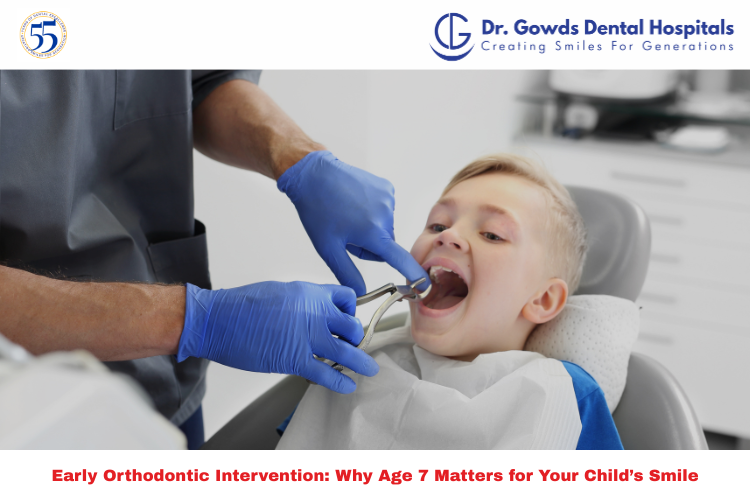Schedule Appointment




As a parent, you’ve probably already got a mile-long list of things to keep track of: school, meals, screen time, activities—the works. So, thinking about orthodontics when your child is only 7 years old? It might not even be on your radar.
But here’s something you should know: checking your child’s dental development around age 7 can actually save you a lot of stress (and money) down the road.
We’re not talking about putting braces on a second grader. This is about spotting small issues early—before they turn into bigger, harder-to-fix problems. At Dr. Gowds Dental Hospital, we focus on early orthodontic intervention because we know how much of a difference it can make for your child’s health, comfort, and confidence.
Let’s walk through why this age matters, what this early phase of care actually looks like, and how it can set your child up for a lifetime of healthier, happier smiles.
Early orthodontic intervention (also called interceptive orthodontics) is just a fancy way of saying “let’s catch and fix small dental or jaw issues before they get bigger.”
Kids’ jaws and teeth are still growing at this age, which makes it the perfect time to gently guide that development in the right direction. It’s not about rushing into treatment—it’s about checking in early so we can either take action or just keep an eye on things.
Sometimes, a simple solution now can prevent complicated treatments later, like pulling teeth, long-term braces, or even surgery.
Seven might seem young, but it’s actually the sweet spot for an orthodontic checkup. At this stage, kids usually have a mix of baby teeth and permanent teeth. That gives us a clear window into how their smile is taking shape.
We can see if the jaws are growing evenly, if there’s enough space for the adult teeth, or if any habits—like thumb sucking or tongue thrusting—are affecting their bite. These are things you can’t always see just by looking, but they matter a lot in the long run.
And the best part? If everything looks good, we’ll just say, “See you in a year.”
You might be surprised by what we’re able to spot at this age. Some of the most common issues we look for include:
Again, catching these things early doesn’t mean your child is getting braces tomorrow. It just means we can help guide things now to avoid bigger problems later.
There are some big upsides to getting ahead of potential dental problems:
If you bring your child in for a pediatric orthodontic visit at Dr. Gowds Dental Hospital, here’s what you can expect:
From there, we’ll either suggest a small treatment plan or just recommend a follow-up in a year or so. Our goal is always to do what’s best for your child—and that often means watching and waiting rather than acting right away.
If we do suggest early orthodontic intervention, it’ll likely be something simple and kid-friendly, like:
We’ll explain everything in plain language, make sure your child is comfortable, and walk you through every step.
You’re a key part of the team! Here’s how you can support your child if they start early treatment:
If your child begins early orthodontic intervention, we’ll likely continue monitoring their growth with check-ins every 6 to 12 months. Later on, if full braces are needed, we’ll be ready—but we’ll also have already laid the groundwork for a much smoother process.
And if your child doesn’t need anything right now? Great—we’ll just keep checking in and cheering on their healthy development.
It might feel early, but that first orthodontic checkup around age 7 is one of the smartest things you can do for your child’s long-term dental health. Even if everything looks fine (and often it does!), it’s still a huge relief to know that early.
At Dr. Gowds Dental Hospital, we’re here to make that process simple, supportive, and stress-free—for both you and your child.
Ready to schedule that first checkup? Let’s get your child smiling with confidence today—and for years to come.
It’s an early approach to spotting and gently correcting issues with jaw and tooth development—usually around age 7.
This is when kids have a mix of baby and adult teeth, which lets us see how their smile is developing and catch potential issues early.
Crossbites, spacing or crowding, jaw growth concerns, and habits like thumb sucking can all be addressed through early care.
Sometimes, yes. In other cases, it might just make future treatment quicker, easier, and less invasive.
Usually once or twice a year—just to keep an eye on how everything’s growing.